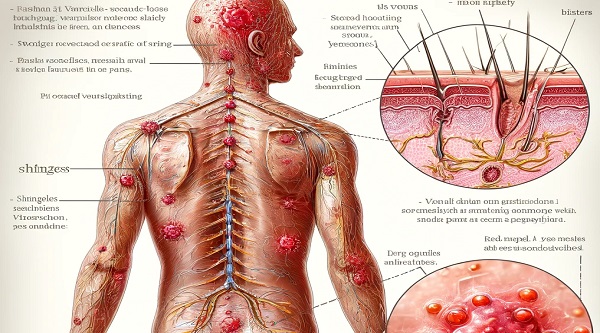Shingles, also known as herpes zoster, is a viral infection that causes a painful rash. It is caused by the varicella-zoster virus, the same virus that causes chickenpox. After an individual recovers from chickenpox, the virus lies dormant in the body and can reactivate years later as shingles. This article delves into the causes, symptoms, and treatment options for shingles, providing a comprehensive understanding of this condition.
Causes of Shingles
The primary cause of shingles is the reactivation of the varicella-zoster virus. After a person has had chickenpox, the virus remains inactive in nerve tissue near the spinal cord and brain. For reasons not fully understood, the virus can reactivate, travel along nerve pathways to the skin, and cause shingles.
Several factors may increase the risk of the virus reactivating, including:
- Age: Shingles is more common in people over the age of 50. The risk increases with age.
- Weakened Immune System: Conditions that weaken the immune system, such as HIV/AIDS, cancer, or treatments like chemotherapy, can increase the likelihood of shingles.
- Stress: High levels of stress may contribute to the reactivation of the virus.
- Certain Medications: Drugs that suppress the immune system, such as steroids and immunosuppressants, can increase the risk of developing shingles.
Symptoms of Shingles
Shingles typically affects only a small section of one side of the body. The most common symptoms include:
- Pain, Burning, or Tingling: This is often the first symptom of shingles. The pain can be intense and is usually localized to the area where the rash will develop.
- Red Rash: A few days after the pain begins, a red rash will appear. The rash usually occurs in a single stripe on one side of the body, often around the torso, but it can also occur on the face, neck, or other areas.
- Fluid-Filled Blisters: The rash develops into fluid-filled blisters that break open and then crust over.
- Itching: The affected area may become itchy.
Other symptoms may include:
- Fever
- Headache
- Sensitivity to Light
- Fatigue
In some cases, shingles can lead to complications such as postherpetic neuralgia (PHN), where the pain from shingles continues long after the blisters have healed. PHN can be severe and last for months or even years.
Treatment Options for Shingles
While there is no cure for shingles, early treatment can help reduce the severity and duration of symptoms. Treatment options include:
- Antiviral Medications:
- Acyclovir (Zovirax)
- Valacyclovir (Valtrex)
- Famciclovir (Famvir)
These antiviral drugs can help speed up the healing process and reduce the risk of complications if taken within 72 hours of the onset of symptoms.
- Pain Relief:
- Over-the-Counter Pain Relievers: Nonsteroidal anti-inflammatory drugs (NSAIDs) such as ibuprofen or acetaminophen can help manage pain.
- Prescription Pain Medications: For severe pain, doctors may prescribe stronger pain relievers, such as opioids.
- Topical Analgesics: Creams containing lidocaine or capsaicin can provide localized pain relief.
- Anticonvulsants and Antidepressants: Medications like gabapentin, pregabalin, or tricyclic antidepressants can be effective for nerve pain.
- Corticosteroids:
- In some cases, corticosteroids may be prescribed to reduce inflammation and pain.
- Cool Compresses and Soothing Lotions:
- Applying cool, wet compresses to the rash can help reduce itching and pain. Calamine lotion may also provide relief.
Preventing Shingles
The most effective way to prevent shingles is through vaccination. The shingles vaccine is recommended for adults over the age of 50 and for individuals with certain health conditions that increase the risk of shingles. There are two vaccines available:
- Zoster Vaccine Live (Zostavax): This vaccine is given as a single injection and has been shown to reduce the risk of shingles by about 51%.
- Recombinant Zoster Vaccine (Shingrix): Shingrix is given in two doses, two to six months apart, and is more than 90% effective in preventing shingles and PHN.
Conclusion
Shingles is a painful condition caused by the reactivation of the varicella-zoster virus. Understanding the causes, recognizing the symptoms, and seeking early treatment are crucial in managing the condition. Vaccination remains the most effective way to prevent shingles and its complications. By staying informed and taking preventive measures, individuals can reduce their risk and improve their quality of life.
